Urban pollinator borders are living fences that support essential insect species while enhancing your property boundaries. You’ll create habitat connectivity by selecting native plants that bloom throughout the growing season, from early spring Wild Geranium to fall Smooth Blue Aster. Design your border with multiple layers—trees, shrubs, and ground cover—to maximize biodiversity. Avoid chemical pesticides and engage your community in maintenance efforts. With proper planning, your living fence will transform into a thriving ecosystem for generations.
The Ecological Value of Pollinator Borders in Urban Environments
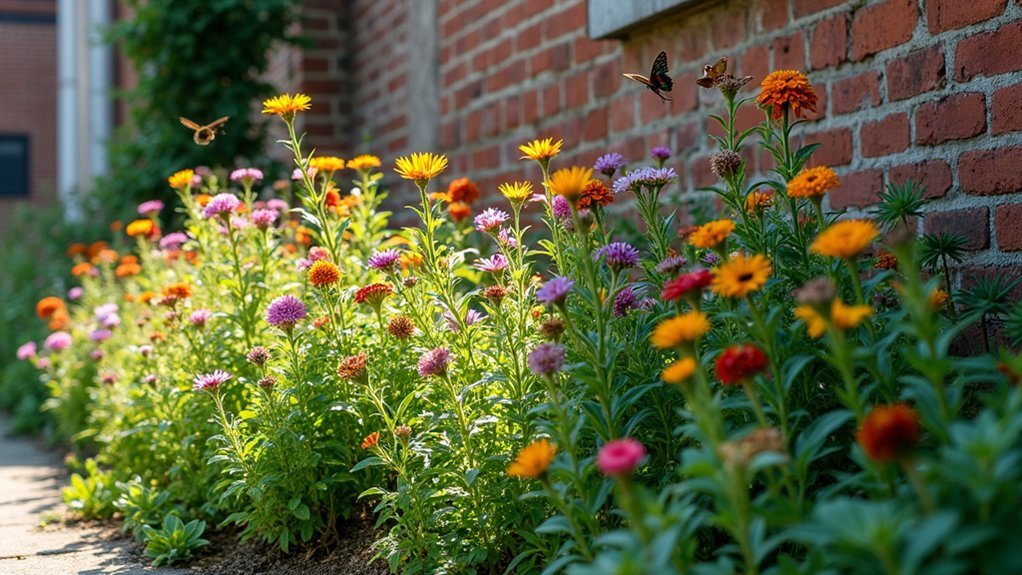
While concrete and asphalt dominate our cities, urban pollinator borders offer crucial ecological sanctuaries that transform the landscape. These living fences support over 75% of crops that rely on insect pollination, creating essential connections in fragmented urban ecosystems.
When you incorporate native plants into pollinator gardens, you’re greatly improving pollinator health while reducing pest problems. These plants have co-evolved with local pollinators, creating natural partnerships that strengthen your local food web.
Beyond supporting biodiversity, these borders deliver critical ecosystem services by cooling urban heat islands and enhancing productivity in nearby gardens.
Your pollinator border isn’t just beautiful—it’s a functioning ecological system that benefits the entire community while creating corridors that help pollinators navigate through urban environments.
Historical Roots of Living Fences and Hedgerows
Living fences trace back 12,000 years as ancient boundary markers, with Neolithic farmers establishing the first hedgerows to protect their livestock and define territorial limits.
You’ll find cultural protection practices embedded in these living boundaries, from Mesopotamian willow barriers against erosion to Medieval English hedgerows that symbolized power and legal ownership.
These natural borders often served as spiritual land markers in traditional societies, with certain plants and trees holding sacred significance as they connected communities to both their physical territories and ancestral beliefs.
Ancient Boundary Traditions
The roots of urban pollinator borders stretch deep into human history, where ancient peoples recognized the practical value of living boundaries. Nearly 12,000 years ago, neolithic farmers pioneered hedgerows to manage livestock and ward off predators, establishing the first living fences that would evolve across civilizations.
In Mesopotamia, you’ll find evidence of willow fences that served dual purposes: protecting crops while combating erosion.
These ancient boundary traditions weren’t merely functional—they carried profound cultural significance. Sacred hedges delineated holy spaces, intertwining the natural world with spiritual practices.
Cultural Protection Practices
Throughout countless generations, communities worldwide have woven their cultural identities into living barriers that transcend mere functionality. You’ll find that these cultural practices often blended practical protection with spiritual significance.
| Region | Living Fence Type | Cultural Significance |
|---|---|---|
| Medieval England | Hedgerows | Power symbols, legal boundaries |
| Latin America | Acacia trees | Village security barriers |
| Africa | Erythrina trees | Agricultural resilience |
| Ancient Mesopotamia | Willow fences | Field protection, erosion control |
| Neolithic Europe | Mixed hedgerows | Livestock containment |
When you examine these traditions closely, you’ll notice how flowering plants weren’t just decorative but served as markers of territory and identity. Sacred groves demarcated holy spaces, while living fences simultaneously protected crops and enriched soils. These practices demonstrate how cultures integrated ecological knowledge with community needs, creating sustainable systems that lasted millennia.
Spiritual Land Markers
Since time immemorial, hedgerows and living fences have served as powerful spiritual markers across diverse civilizations, connecting earthly boundaries with cosmic significance.
You’ll find these botanical boundaries dating back to 10,000 BCE, when ancient cultures used them to protect sacred spaces while simultaneously preserving biodiversity.
- Ancient Mesopotamia: Willow fences transcended practical protection, symbolizing boundaries between the mundane and divine domains.
- Medieval England: Hedgerows represented power and legal ownership while fostering rich ecosystems that sustained wildlife.
- Renaissance Gardens: Living fences demonstrated human mastery over nature while creating spaces of beauty and spiritual contemplation.
These living markers weren’t merely physical boundaries—they embodied humanity’s attempt to harmonize practical needs with spiritual beliefs, reinforcing connections between nature, community, and the divine.
Selecting Native Plants for Your Pollinator Border
When planning your urban pollinator border, choosing native plants should be your top priority. These plants have co-evolved with local pollinators, ensuring mutual benefits and superior adaptation to your region’s conditions.
Focus on incorporating a diverse mix of pollinator plants that bloom sequentially throughout the growing season. Early bloomers like Wild Geranium paired with late-season options such as Smooth Blue Aster provide continuous nectar sources.
Prioritize perennials like Bee Balm and Butterfly Weed, which offer sustained support while requiring less maintenance than annuals.
Don’t forget to include “magnet species” like Milkweed, which is essential for Monarch butterflies.
Structural Elements and Support Systems for Living Fences
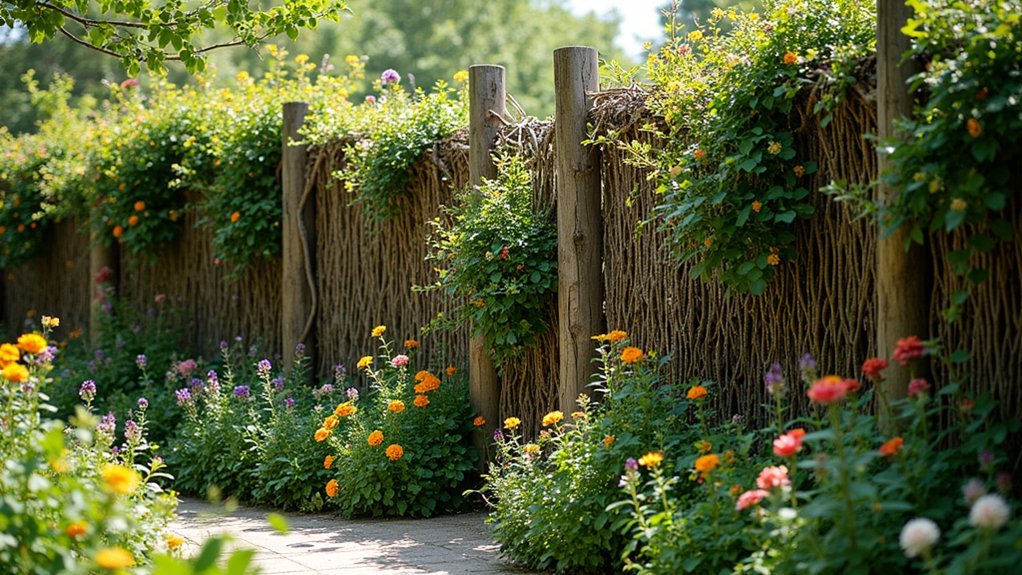
Your living fence needs a robust foundation framework to thrive, with options ranging from simple wooden trellises to more durable cattle panels or wire mesh systems that provide long-term support.
When training young climbers, you’ll want to secure them with soft plant ties that won’t damage delicate stems while guiding their growth in your desired direction.
These structural elements aren’t just functional necessities—they’re design opportunities that can enhance the aesthetic appeal of your urban pollinator border while creating the perfect architecture for your plants to flourish.
Foundation Framework Options
The foundation of any successful urban pollinator border lies in its underlying support structure. When designing your living wall, choose frameworks that accommodate multiple layers of vegetation to create a rich pollinator garden ecosystem.
You’ll need robust supports that can handle the weight and growth patterns of your selected plants.
- Wooden frameworks – Ideal for traditional gardens, they provide natural aesthetics and can be customized with trellises for climbing varieties.
- Metal systems – Wire mesh or cattle panels offer excellent durability and transparency, allowing plants to weave through while maintaining structural integrity.
- Hybrid solutions – Combine posts with horizontal supports at varying heights to create multiple layers of planting opportunities for trees, shrubs, and herbaceous perennials.
Train young plants with soft ties to guide their growth along your chosen framework.
Training Young Climbers
Successfully establishing a thriving pollinator border depends largely on how well you train your young climbing plants during their formative stages.
Select appropriate structural support based on your specific climbers – wisteria and climbing hydrangea flourish on wooden trellises, while wire mesh or cattle panels work well for lighter vines.
When training young climbers, gently guide them along their supports using soft plant ties, which encourages healthy vertical growth without damaging tender stems.
Some vigorous varieties will need regular pruning to manage their development and enhance flowering, while others require minimal intervention.
Consider incorporating decorative elements like arches or arbors that serve dual purposes – providing essential support while adding visual interest to your living fence.
For a layered effect, you might pair climbers like coral honeysuckle that naturally intertwine with complementary varieties.
Seasonal Planning for Year-Round Pollinator Support
Creating effective urban pollinator borders requires thoughtful seasonal planning to guarantee continuous support for bees, butterflies, and other beneficial insects.
By incorporating plants with staggered bloom times, you’ll establish a pollinator friendly ecosystem that provides consistent food sources throughout the growing season.
- Early spring: Plant native Wild Geranium and Columbine to attract first-emerging pollinators when other food sources are scarce.
- Summer abundance: Include a variety of mid-season bloomers that match the foraging preferences of your local pollinator species.
- Fall sustenance: Incorporate late-blooming plants like Smooth Blue Aster to support pollinators preparing for winter.
Don’t forget regular maintenance like deadheading spent blooms to extend flowering periods.
This seasonal planning approach guarantees your urban border remains a vibrant habitat supporting biodiversity year-round.
Creating Multi-Layer Habitats Within Boundary Plantings
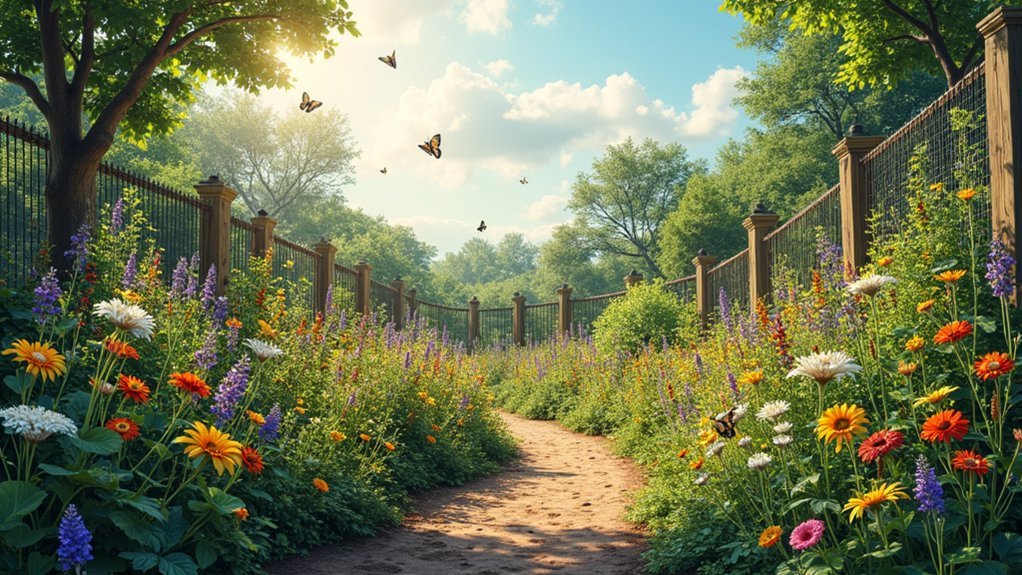
When designed with ecological principles in mind, urban pollinator borders transform from simple plantings into complex, multi-dimensional ecosystems that mimic natural habitats.
To maximize your green space’s ecological value, structure your living fence in three distinct layers.
Start with a top layer of smaller trees like pawpaw or dogwood, which provide shelter and vertical structure. The middle layer should feature pollinator-friendly shrubs such as American beautyberry and buttonbush, offering berries for birds and nectar for bees.
Complete your multi-layer habitat with a ground layer of host plants like golden alexanders and wild violets, which support caterpillars and consequently, seed-eating birds.
This layered approach not only creates aesthetic boundaries but establishes essential corridors for pollinators, helping counteract habitat loss while enhancing urban biodiversity.
Maintenance Practices for Sustainable Pollinator Borders
To maintain the ecological integrity of your urban pollinator border, you’ll need to adopt sustainable practices that nurture both plants and their pollinator visitors. Regular pruning of vigorous climbers in your living fence prevents overcrowding while preserving the structure that attracts pollinators and wildlife.
- Test your soil for toxicity before planting to create a safe environment for native plants and the pollinators they attract.
- Implement organic gardening practices, avoiding chemical pesticides that harm beneficial insects visiting your border.
- Follow a strategic maintenance schedule that includes pruning climbers like Wisteria and ensuring continuous blooms by selecting plants with different flowering periods.
This layered approach to maintenance—addressing soil health, plant diversity, and structural integrity—ensures your pollinator border remains vibrant and ecologically valuable year-round.
Community Engagement and Educational Opportunities
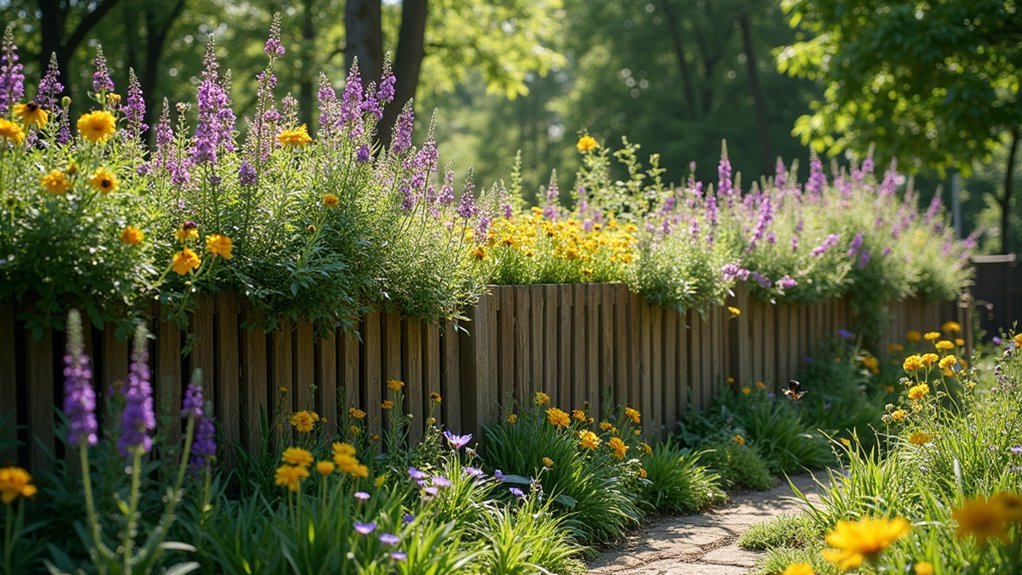
Urban pollinator borders flourish beyond their ecological value when communities rally behind them as shared educational resources.
You’ll find that organizing workshops on native plant selection empowers your neighbors to design pollinator-friendly gardens that support local biodiversity.
Partner with schools to incorporate these living laboratories into their curriculum—students gain hands-on experience while understanding the vital role pollinators play in our food systems.
This addresses the troubling reality that less than 0.007% of news coverage mentions pollinator decline.
Connect with organizations like the Pollinator Partnership to access resources that amplify your community engagement efforts.
Case Studies: Successful Urban Pollinator Borders
Across America’s most innovative cities, pollinator borders have transformed concrete jungles into thriving ecological havens. These urban areas have intentionally created habitats that support diverse pollinator populations through strategic planning and community involvement.
- New York City’s community gardens and green rooftops now host over 200 bee species, with Brooklyn Botanic Garden’s pollinator garden showcasing native plants that educate visitors about biodiversity.
- Chicago’s Pollinator Partnership has established 50+ gardens citywide, increasing pollinator visitation rates by 30% and revitalizing previously underutilized spaces.
- Philadelphia and San Francisco demonstrate measurable success with their initiatives—Philadelphia’s corridors boosted native bee abundance by 25%, while San Francisco’s program engaged residents to achieve a 40% increase in pollinator activity.
You’ll find these case studies provide compelling evidence for implementing similar projects in your community.
Frequently Asked Questions
How Do Pollinator Borders Affect Property Values?
Pollinator borders can boost your property value by enhancing curb appeal, supporting biodiversity, and attracting eco-conscious buyers. You’ll likely see increased interest and higher offers when your garden includes these attractive, sustainable features.
Can Pollinator Borders Help Reduce Noise Pollution?
Yes, pollinator borders can help reduce noise pollution. You’ll find they act as natural sound barriers, absorbing and deflecting sound waves, especially when you’ve planted dense, layered vegetation with varying heights and textures.
What Permits Might I Need for Installing Urban Pollinator Borders?
You’ll likely need landscaping permits, zoning approvals, and possibly right-of-way permits from your city planning department. For public spaces, additional environmental assessments might be required. Check your local municipal code for specifics.
How Do Pollinator Borders Interact With Existing Utility Infrastructure?
You’ll need to maintain clearance around utility lines, meters, and access points. Don’t plant tall species under power lines. Always call 811 before digging to prevent damage to underground infrastructure like gas pipes.
Are There Liability Concerns With Attracting Stinging Insects?
Yes, you’ll face liability concerns when attracting stinging insects. You should post warning signs, choose less aggressive pollinator species, maintain adequate distance from high-traffic areas, and check your insurance policy for coverage.
In Summary
You’ve learned how living fences can transform urban boundaries into vibrant ecosystems. By planting native species, designing thoughtful structures, and planning for year-round support, you’re not just creating a beautiful border—you’re building essential habitat for pollinators. Whether you’re a homeowner or community organizer, these living boundaries connect fragmented urban landscapes while bringing nature’s services back to our cities. Start small, grow big.

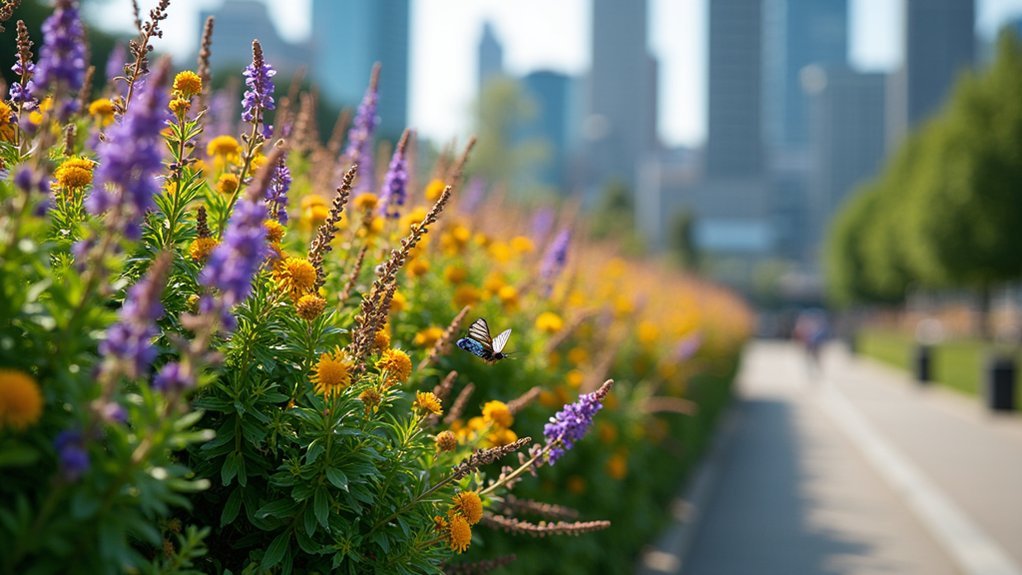



Leave a Reply